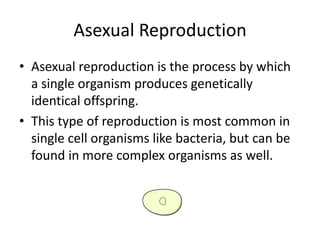Asexual Propagation Definition
Plants naturally present two types of asexual reproduction. How to use asexual in a sentence.

Asexual Vs Sexual Reproduction
This is the most common and widely used form of vegetative propagation.

. Asexual propagation can be done in a variety of ways. Positive genetic influences pass on to successive generations. Following are the advantages of asexual reproduction.
From microorganisms to larger organisms including all plants and animals. Medical Definition of asexual reproduction. Mates are not required.
Cuttings Cutting a portion of a leaf stem or root off the parent plant then replanting and therefore the plant begins to grow. Budding fragmentation vegetative propagation and the formation of spores are all. Fragmentation or vegetative propagation through the detachment of sections of modified stems roots or leaves and apomixis the formation of unfertilized seeds.
The creation of a similar object or situation. This method is so-termed sexual because there is the involvement of the sexes referring to the contribution of both the male and female. Various asexual propagation methods exist such as growth from tubers bulbs rhizomes and stolons taking stem cuttings leaf cuttings cane cuttings.
Asexual reproduction definition reproduction as budding fission or spore formation not involving the union of gametes. It occurs in various environments. Definition of Asexual Reproduction In Plants.
Asexual reproduction is the development of a new species from an individual parent without involvement of sex or gametes cells. The meaning of ASEXUAL is lacking sex or functional sex organs. Reproduction as cell division spore formation fission or budding without union of individuals or gametes.
Asexual propagation is a type of plant reproduction using roots stems or leaves of a parent plant. Asexual propagation also called vegetative propagation is accomplished by taking cuttings by grafting or budding by layering by division of plants or by separation of specialized structures such as tubers rhizomes or bulbs. Clones are groups of plants that are identical to their one parent and that can only be propagated asexually.
Asexual reproduction is a type of reproduction in which a single parent cell is involved in making a new offspring. Sexual propagation is with the use of a seed or spore that is separated from the parent plant. Asexual reproduction refers to the formation of a new organism from a single parent with no involvement of gametes or sex cells.
It is seen in every living organism. There are different types of asexual reproduction like 1 binary fission 2 budding 3 vegetative propagation 4 spore formation 5 fragmentation 6 parthenogenesis 7 apomixis. Each of the cells can grow and reproduce also.
In general there are two methods of propagating plants. An enormous number of organisms can be produced in very less time. Fragmentation is the most common type of asexual reproduction in plants and is based on the presence of meristematic.
Based on the number of parents involved and the formation and fusion of gametes. The process of reproduction is rapid. The deliberate directed reproduction of plants using plant cells tissues or organs.
The Kieffer pear and the Peace Rose are two examples of. The sex glands or gonads the ovaries in the female and the testes in the male produce the germ cells ova and sperm that unite and grow into a. Asexual propagation produces a genetically identical plant to the parent plant.
Asexual reproduction is used by many unicellular and multicellular organisms. Grafting Grafting is propagation by combining a scion of one. The process by which a living entity or organism produces a new individual of the same kind.
Budding fragmentation vegetative propagation and spore formation take place in the process of. Advantages of Asexual Reproduction. Asexual reproduction is utilized by numerous multicellular and unicellular organisms.
It is the basis for continuing life from generation to generation. Asexual Reproduction in Plants Definition. The process of dividing into two identical cells is called binary fission.
Asexual reproduction is observed in both multicellular and unicellular. Plant Propagation Methods. Asexual propagation multiplication without passage through the seed cycle is the best way to maintain some species particularly an individual that best represents that species.
Any kind of sexual gametic fusion between male and female gamete is not involved and the number of chromosomes remains the same as the mother cell. Reproduction is a biological process of producing offspring of a living organism.

Asexual Reproduction In Plants Class 7 Reproduction In Plants Science

Asexual Propagation Green Is Life


Comments
Post a Comment